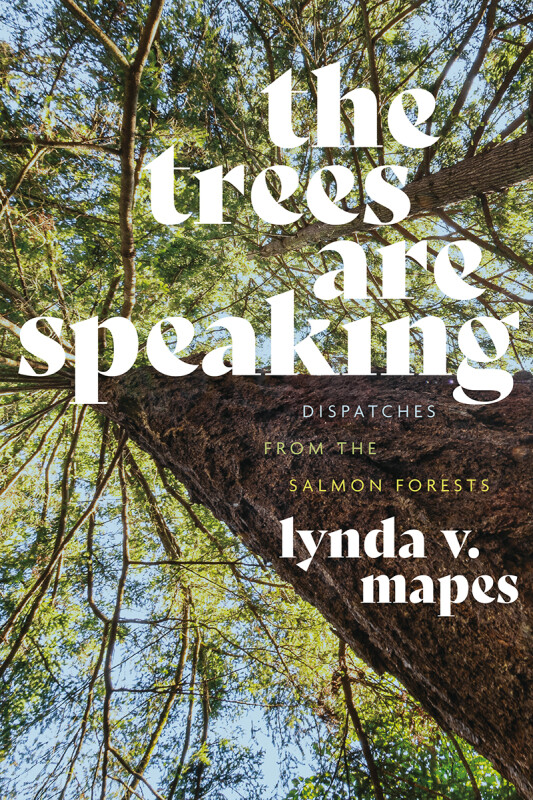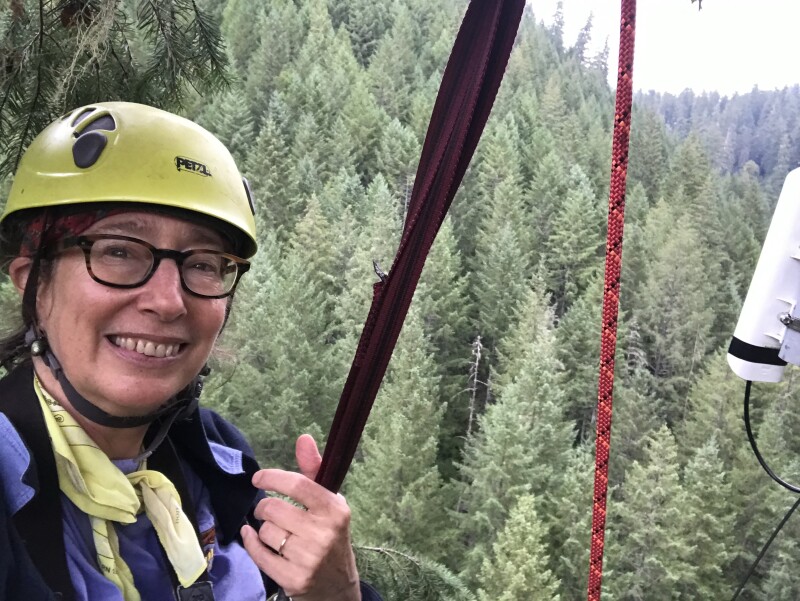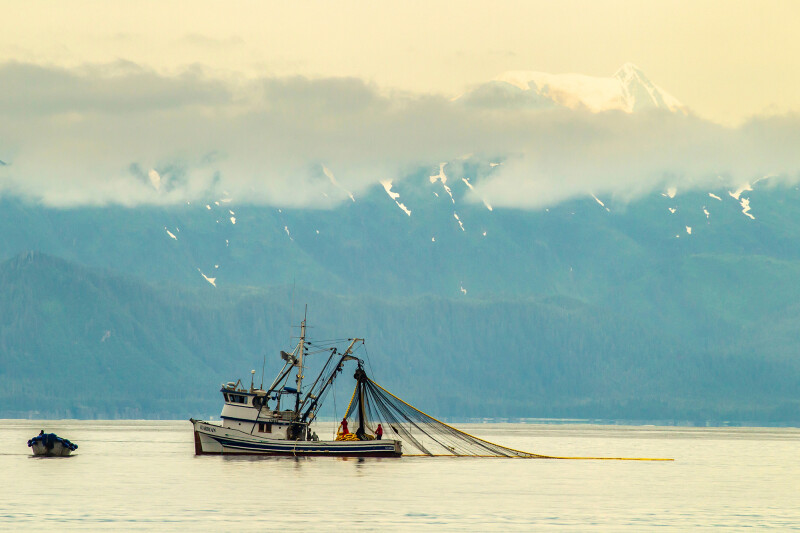From a Pacific Northwest writer who has tracked the relationship of wild salmon and forest trees from Oregon's Cascade Range in the Pacific Northwest to the Penobscot River in Maine has come a warning.
"The salmon and the forests are speaking," writes Lynda Mapes, an environmental journalist with The Seattle Times, "and what they are telling us is we are about out of time."
"The Trees are Speaking: Dispatches From The Salmon Forests," published by the University of Washington Press, documents massive misuse and destruction of the nation's old-growth forests, including the corrosive impact on wild salmon, but is also a message of hope, even in the face of climate change.

In her travels researching the book, Mapes introduces the reader to the likes of salmon and forest wise folks from Theresa Ryan of the University of British Columbia to Rory Saunders of NOAA Fisheries in Orono, Maine, with a good measure of Native elders like Penobscot artist Butch Philips thrown in.
"This signature of the salmon in the trees is one of the characteristics of old-growth forests," explains Ryan, an indigenous knowledge and natural science lecturer at the Department of Forest & Conservation Sciences at the University of British Columbia in Vancouver, Canada. Forests and salmon are connected, and without the forest, we wouldn't have salmon, said Ryan. The trees are part of these cycles, and shrinking the size and abundance of salmon returning to these river landscapes breaks the cycle of nutrients coming home to the land from the sea, she told Mapes.
Ryan was engaged in field work with Suzanne Simard, an eminent forest ecologist and professor in the same department at UBC, as part of the Mother Tree Project crew researching a time sequence of the amount of carbon stored in the massive B.C. logging clear-cuts. The Mother Tree Project is compiling the data for a rescue plan for forests that were cut over and replanted to monocultures, to protect biodiversity, carbon storage, and forest regeneration in the face of climate change. Simard, descended from a family of hand loggers in rural British Columbia, aims to demechanize and deconstruct these forests in order to reconstruct and heal them.
Cutting those big old growth trees has endangered Pacific salmon runs all over British Columbia, fish who have come home after two to seven years in the sea to spawn in clean gravel in river systems complex with dead and downed logs that create shadowy pools, a place for salmon to hide, rest and feed at every life stage. Nitrogen from the spawned-out salmon offers a boost to the growth of the old trees, as does the excrement from bears, wolves and other critters who eat the salmon after dragging them into the trees, carrying the nutrition even farther into the forest.
Mapes makes her way east to Maine, where sawmills were once everywhere, a total of 746 sawmills by 1820, including mills on the Penobscot River and its tributaries north of Bangor, cutting millions of board feet a year. There, the destruction of forests and salmon streams prevailed, as rivers became sluiceways to drive logs to mills. It wasn't until the passage of the Clean Water Act in 1972 and the completion of a road allowing truck hauling of logs that there was an end to the river log drives, which were outlawed by the Maine Legislature in 1975.
Mapes documents in detail the progressive destruction of the northern Maine forests in the 1980s until a public outcry led to a series of reforms beginning in 1989 that reduced clearcuts but had perverse consequences, with the fragmenting of the forests for logs doubled. At that time, nearly half of the state's forestlands were owned by eight Fortune 500 paper corporations and sawmills or other manufacturers.
The story of New England, observes Mapes, is the story of the continent's first round of industrial booms and busts, with the timber and paper barons gnawing the place bare.
Today, the Penobscot Nation is still working to improve the health of the Penobscot River, where fishing is prohibited for the King of Fish, but some progress has been made. Fisheries biologists with the National Oceanic and Atmospheric Administration are conducting boat surveys every two weeks, from the earliest ice-out in spring to ice-in by winter, to track ecosystem-level changes in the estuary of Penobscot Bay. Atlantic salmon remain at high risk of extinction.
Overfishing, pollution, egregious habitat destruction, and the more than 100 dams built as early as the 1830s in this river basin have all imperiled fish native to the Penobscot, but a $64 million Penobscot River Restoration Project is underway.
The project is rooted in a historical settlement agreement to initiate the restoration plan, signed by the Penobscot Nation, five non-profits, and state and federal agencies in 2004. With this watershed agreement, negotiators mastered a compromise that improved fish passage while increasing the amount of hydropower generated on the river. Dam removal began in June of 2012. A new fish lift, informally known as The Salmonater, lifts fish over Maine's Milford Dam, and hatcheries have been crucial for conserving this species.

John Kocik, chief of Atlantic salmon ecosystems research for NOAA Fisheries, told Mapes all this work has helped fish recovery, but it is just a start. Hundreds of barriers, including culverts and dams, still block fish migration in the Penobscot watershed, and passage, even where provided, is under scrutiny, Mapes notes. Helping the salmon thrive in the Penobscot River is also hoped to boost the web of life at sea, where more fish out-migrating from the river means more food for cod, pollack, and haddock, in an unending cycle of renewal, she said.
River recovery in Maine has become a movement about not only dam removal and salmon, but a multispecies recovery and improving habitat conditions in streams throughout the historic range of sea-run fish. The tributaries also have to provide a healthy habitat to nurture the fish once they get there.
"Until people accept there's a problem, and are willing to do something about it, and to accept we are damaging our future, until we accept that, there's not going to be any progress," said Butch Phillips, an elder Penobscot artist.
"But they need to understand, we are all connected to Mother Earth and any damage we do to Mother Earth, we do to ourselves," he told Mapes. "The circle of life, the animals, the plants, the insects, the trees, everything is in this circle. And it is all connected."
Part of what they are fighting is collective amnesia, said Steven Koenig, associate director of Project SHARE in Eastport, Maine, which is dedicated to enhancing salmon habitat. Salmon and other sea-run fish have been gone for so long that people have forgotten about them, Mapes notes.
Mapes, who has an acknowledged fascination with ancient forests, begins and concludes her journey at the H.J. Andrews Experimental Forest, east of Eugene, Oregon, an area noted for its mild climate and wet winters. Andrews was established as a research forest in 1948 by the U.S. Forest Service. In 1980, the Andrews became a charter member of the Long Term Ecological Research Network, funded by the National Science Foundation. After 15 months of researching her book on both sides of the U.S.-Canadian border and the North American continent, she returned to inhale again the scent of that vintage forest and see the trees. Less than two weeks later, a lightning strike ignited a fire that burned 25,754 acres, about 68% of Andrews. The damage done, autumn rains eventually doused the flames.
Despite all past destruction of fish habitat, Mapes is hopeful. "Change is possible," she writes. "The work on the Penobscot River and its tributaries is proving that. The question in my mind is whether more of these sorts of changes can happen at big enough scale, quickly enough."







